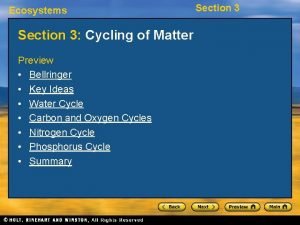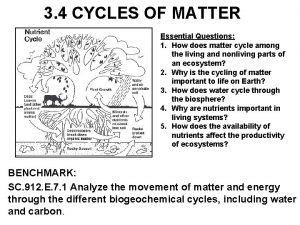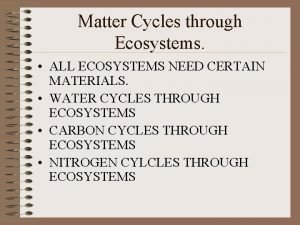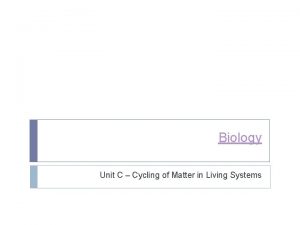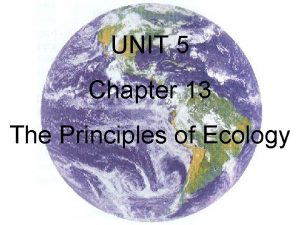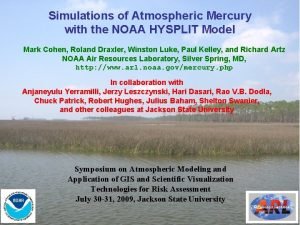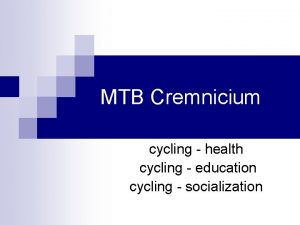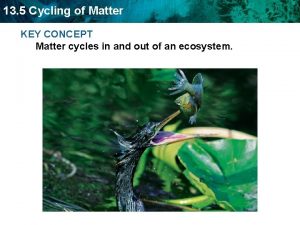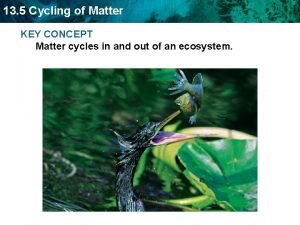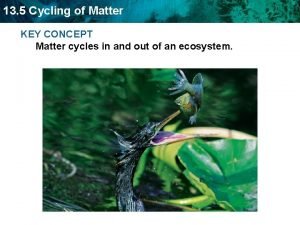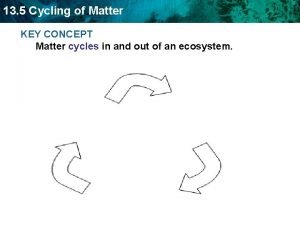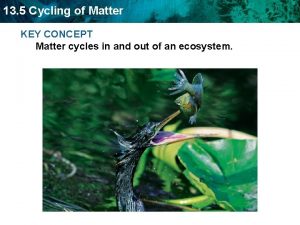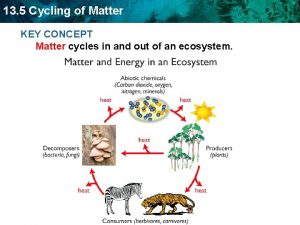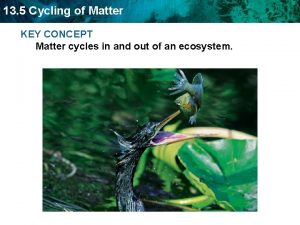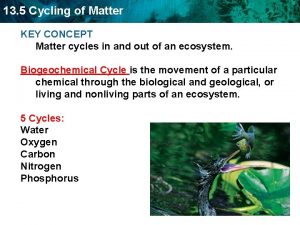13 5 Cycling of Matter KEY CONCEPT Matter











- Slides: 11

13. 5 Cycling of Matter KEY CONCEPT Matter cycles in and out of an ecosystem.

13. 5 Cycling of Matter Elements essential for life also cycle through ecosystems. • A biogeochemical cycle is the movement of a particular chemical through the biological and geological parts of an ecosystem.

13. 5 Cycling of Matter • The hydrologic, or water cycle is the circular pathway of water on Earth from the atmosphere, to the surface, below ground, and back • Evaporation • Cloud formation • Precipitation • Transpiration (loss of H 2 O from plants) • Condensation • Runoff

13. 5 Cycling of Matter Hydrologic Cycle – Precipitation: rain or snow falls to ground – Water seeps into ground, ponds, streams, swamps, wetlands, lakes, etc. – Empty into oceans – Evaporation: water reenters atmosphere Transpiration: water vapor released by plants – Condensation: water vapor in atmosphere creates clouds

13. 5 Cycling of Matter • Oxygen cycles indirectly through an ecosystem by the cycling of other nutrients. oxygen photosynthesis respiration carbon dioxide

13. 5 Cycling of Matter Oxygen Cycle • • Plants release oxygen as waste during photosynthesis Animals breathe in oxygen Animals release carbon dioxide during cellular respiration Plants take in carbon dioxide

13. 5 Cycling of Matter • Carbon is the building block of life. – The carbon cycle moves carbon from the atmosphere, through the food web, and returns to the atmosphere. Carbon Dioxide in air Photosynthesis respiration decomposition Burning of Fossil fuels Carbon Dissolved In water

13. 5 Cycling of Matter Carbon Cycle • Plants use energy from the sun to convert carbon dioxide into sugar that become part of the plant’s structure • Moves to animals as they eat plants and as one organism eats another • Carbon is returned to the atmosphere by: – 1. respiration – 2. decomposition of dead organisms – 3. Burning of fossil fuels and wood – 4. Emissions from factories/cars – 5. Methane emission from wetlands/landfills/livestock

13. 5 Cycling of Matter • The nitrogen cycle mostly takes place underground. nitrogen in atmosphere animals plant nitrogen-fixing bacteria in decomposers roots ammonification nitrogen-fixing ammonium bacteria in soil nitrifying bacteria nitrates nitrifying bacteria nitrites denitrifying bacteria

13. 5 Cycling of Matter Nitrogen Cycle • Bacteria turns gaseous nitrogen into ammonia • Ammonia released into the soil is transformed into ammonium by materials in the soil • Nitrifying bacteria change the ammonium into nitrate • Nitrate is taken up by plants • Plants convert the nitrate into amino acids and proteins • Nitrogen moves through the food web as animals eat plants and/or other animals • Nitrogen returned to soil as decomposers break down animal excretions or dead animals • Denitrifying bacteria use nitrate as an oxygen source, releasing nitrogen gas into the atmosphere as a waste product

13. 5 Cycling of Matter • The phosphorus cycle takes place at and below ground level. – Phosphate is released by the weathering of rocks. – Phosphorus moves through the food web and returns to the soil during decomposition. rain geologic uplifting – Phosphorus leaches into groundwater weathering of phosphate from rocks from the soil and runoff plants is locked in sediments. animalsphosphate in solution in soil – Both mining and leaching agriculture add sedimentation phosphorus into decomposers forms new rocks the environment.
 Section 3 cycling of matter
Section 3 cycling of matter Section 1 organisms and their relationships answer key
Section 1 organisms and their relationships answer key 4 cycles of life
4 cycles of life Section 1 organisms and their relationships
Section 1 organisms and their relationships Matter cycling in ecosystems
Matter cycling in ecosystems Chapter 2 principles of ecology
Chapter 2 principles of ecology Cycling of matter definition biology
Cycling of matter definition biology Chapter 2 section 1 classifying matter answers
Chapter 2 section 1 classifying matter answers Chapter 4 lesson 4: metamorphic rocks answer key
Chapter 4 lesson 4: metamorphic rocks answer key Lesson 1 waves answer key
Lesson 1 waves answer key A bird stalks kills then eats
A bird stalks kills then eats Cycling swanier
Cycling swanier
